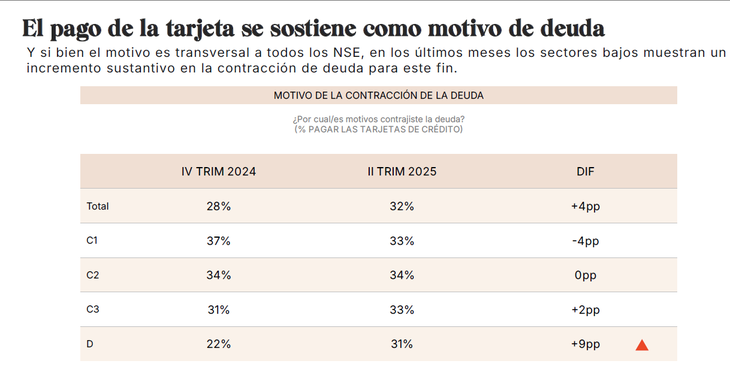According to data from the LCG consultancy, Consumption loans contributed only 0.5 percentage points to the general variation of the credit during the past month. Faced with June, they grew only 1% in real terms, well below the semiannual average that was around 4%. The slight monthly advance is mainly explained by personal loans, which rose 1.7% real. Instead, the Credit card financing barely increased a real 0.4%.
This stagnation occurs in a scenario where household debt already shows signals of deterioration. The latest BCRA Banks Report (May 2025) indicates that the delinquency of the credit to the private sector went from 1.8% in June 2024 to current 2.6%. The deterioration is even more notorious in the lines linked to consumption: on credit cards, Mora practically doubled (from 1.9% to 3.8%) and in personal loans rose from 4.1% to 5.6% in just twelve months.
Screen capture 2025-08-07 094629
The lefis output raised the rates: what effect can it have on consumption
To these signs is added a New element That was not in the papers. The Lefis exit reconfigured the short -term rates. Although in recent days some stability was hinted, the rates rose again, which could move to bank rates.
Guillermo Barbero, partner of First Capital Group, warned, anyway, that rates increases arrive with lag: “They must be communicated in the prior summary to their validity and, in general, the emitting entities try to maintain stability in the financing rates of the card park.”
Credit, consumption and “the two Argentines”
Meanwhile, the Consumption shows an radiography of the two Argentines. A recent study by the Moiguer consultant, entitled “The Pesified Argentina versus the dollarized Argentina,” showed that the growth of consumption is concentrated in the high and medium-middle income sectors. This segment channels its purchasing power towards durable goods and luxury products, taking advantage of the “cheap” dollar.
On the other hand, the middle class and the lower class – which, together, represent 94% of the population, according to the same study – face restrictions. In the middle sectors, salaries lose ground in the face of inflation, and a growing portion of income is destined for tariffs, transport and public services. This situation Not only limits the margin of consumption, but also forces many families to borrow to cover current expenses.
In this context, from Epyca Consultores, they point out that, although private consumption grew in the first quarter ( +2.9% intertrimestral and +11.6% year -on -year), this dynamism was not even. “In the moderate income sectors, many families stopped paying even the minimum payment of their cards, indicating a higher level of critical indebtedness and slows the rebound in mass consumption,” they warn in the report.
For specialists, the evolution of purchasing power will be key to reverse this dynamic. “So that the advance in the means of payment translates into economic dynamism, it is essential that the purchasing power be recovered. A regulation of the financial system that allows to reduce effective rates on consumption credit is also crucial,” they added from Epyca.
In dialogue with ScopeMartín Kalos, director of the consultant, contributed: “The increase in default is not yet worrying at the systemic level, but it is for families that do not reach the end of the month. This delinquency level is marking a roof for the growth of mass consumption. If salaries improved, many families would use that extra income to catch up with their debts. ”
Screen capture 2025-08-07 094337

Card payment affects the low and medium sectors
The tension also impacts the Fintech world, which in recent years grew in the heat of a Unsatisfied credit demand in non -banking sectors. Pablo Blanco, CTO of Alprénamo, was clear in this regard: “The sustainability of this portfolio will largely depend on the evolution of the real salary, the ability of the financial system to absorb credit risk and whether or not public policies offer or not incentives to sustain demand. Nearly monitor the early tension signs will be key to anticipate the next movements of the retail credit”.
Facing the end of the year, Perspectives are not positive. While the consumption of the high sectors could continue to draw certain categories, mass consumption will remain withdrawn. Everything will ultimately depend on two key variables: the increase in homes and rearrangement of interest rates.
Source: Ambito
I am a 24-year-old writer and journalist who has been working in the news industry for the past two years. I write primarily about market news, so if you’re looking for insights into what’s going on in the stock market or economic indicators, you’ve come to the right place. I also dabble in writing articles on lifestyle trends and pop culture news.




